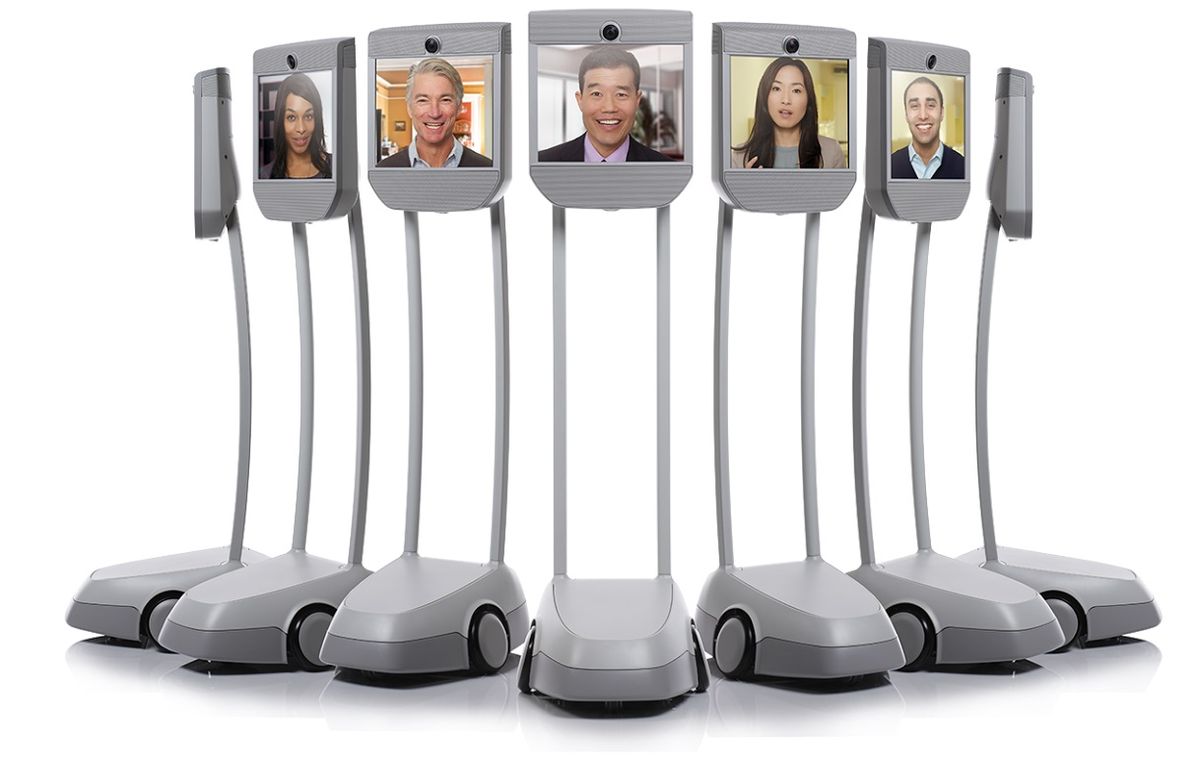We’ve known for quite a while that Suitable Technologies, a spinoff from Willow Garage, has been working on a telepresence robot* of some sort. They’ve just gone public, and here it is: the Beam Remote Presence System, or RPS.
These are the specs on Beam, from the press release:
The Beam Remote Presence System consists of three components: the Beam Remote Presence Device (RPD), the Beam Client and the Beam Dock.The Beam RPD is your physical presence in the world. The battery powers the Beam for up to eight hours of active use and has the ability to drive at human walking speed – with a top speed of 1.5 meters per second. Beam stands 62” tall, weighs 95 pounds, and has a 17" screen, enabling the pilot’s face to be seen at human size. Seamless connectivity is provided by 4 Wi-Fi radios (2.4/5 GHz) and proprietary algorithms to smoothly handle transitions between access points. Beam has two HD cameras to provide a wide field of view, both vertically and horizontally; a six-microphone array for spatialized audio, background noise reduction, and echo cancellation; a sophisticated speaker system in order to be heard in noisy environments; and LED lamps to enable operation in low light.The Beam Client connects to the Beam RPD and provides integrated controls for driving, video, and audio. The client is available for download as an installer on both Windows and Mac OS X.The third component is the Beam Dock, which charges the RPD’s battery. The driver maneuvers the RPD directly into the dock without any local intervention to connect to the power source.
Beam is available now for pre-order, and will begin shipping in November for $16,000. The dock is another $950. As far as telepresence platforms go, this is not cheap: you can buy an Anybots QB for $9,700, a VGo for about $6,000, a Double for just $2,000, and there are many more options as well. So of course, the question is why buy a Beam? Tim Smith, a spokesperson for Suitable, sums it up:
The biggest differentiator of Beam is its ability to stay connected. In our early testing, we learned that it’s not that difficult to build a remote presence device that keeps a wireless connection 70-80% of the time but that absolutely won’t cut it for an enterprise-class product.
We had this experience with our QB when Erico tried it out at Spectrum back in 2010:
One problem I had with my QB experiment was the spotty Wi-Fi coverage in our office (ironic given that IEEE—ahem—created the 802.11, or Wi-Fi, standard). Sometimes the video would freeze or become pixelated. Other times I’d get disconnected from the robot altogether, without even knowing whether the machine had stopped rolling.
So basically, those four (four!) Wi-Fi radios that Beam uses, plus whatever proprietary algorithms Suitable came with, are the reason that you’d buy Beam as opposed to a different system. We haven’t gotten to try out Beam yet, of course, but if the connectivity isn’t as good as Suitable says it is, they’d be kinda nuts to offer up such an expensive platform.
It may seem a bit extreme to charge such a premium for reliable connectivity, but you have to remember what Suitable’s target market is: they want to offer a way for people to work anywhere they want while living anywhere they want. Also from the press release:
With the growth in dispersed workforces, Suitable anticipates early adopters to come from those businesses with remote engineers or knowledge workers. These individuals can then choose their employer based not on the address of the company headquarters, but on the physical location of their preference. Professionally, individuals want the best, most exciting job possible, but professional goals and personal goals are often at odds when it comes to location. With the introduction of Beam, attributes that are more personally appealing such as family, local schools, housing prices, or outdoor hobbies can be equally measured against the attributes of a particular career.
Beam, if you remember, is based on the Texai platform initially developed at Willow Garage. Here’s a picture of Texai:
Texai started off as a way for a Willow employee, Dallas Goecker, to work in Silicon Valley without having to relocate from his home in Indiana. This dictated many of Texai’s features: excellent audio, a head-sized screen at head height, good driving controls, a big battery, and of course connectivity that you can depend on while still moving around as much as you need to. Beam puts a premium (and you will pay a premium) on creating the best remote experience possible: not just a functional experience, but an experience that someone can rely on every day to be a productive member of a remote team.
Again, we’re going to have to wait and see just how good Beam is, and whether it’s worth the equivalent of eight (!) Doubles. We’re not sold yet, but we’re not thinking it’s completely crazy, either: telepresence really is all about the experience, and if Beam can make you comfortably and seamlessly feel like you’re somewhere else, then we’d say that that might possibly justify the premium.
*Arguably (and Suitable makes this argument), Beam is not actually a robot. It all depends on your definition of robot, of course, but if you’re sticking with something that demonstrates autonomy, Beam doesn’t quality: it’s more like a very fancy remote control car.
Evan Ackerman is a senior editor at IEEE Spectrum. Since 2007, he has written over 6,000 articles on robotics and technology. He has a degree in Martian geology and is excellent at playing bagpipes.





